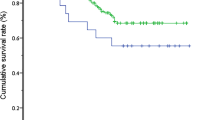Abstract
Kasai portoenterostomy has been the treatment of choice for neonates with biliary atresia since its introduction. With the advance in laparoscopic techniques, a few centers have reported the feasibility of performing laparoscopic Kasai portoenterostomy. However, the outcome of this new technique is not known. Here, we aim to evaluate, as the only referral center for liver transplantation, our experience with patients referred for transplantation after failed Kasai portoenterostomy. A retrospective study was carried out between October 1996 and September 2005. The records of all patients with the diagnosis of biliary atresia were retrieved. The type of procedure and clinical outcome of the patients were noted. Early failure of Kasai enterostomy was defined as the need for liver transplantation within 1-year post-Kasai operation. For the period studied, a total of 72 patients with biliary atresia were identified. Sixty-three of the 72 patients had their Kasai portoenterostomies performed openly while nine patients underwent laparoscopic Kasai portoenterostomy in a center experienced in laparoscopic surgery. Six of these patients were referred for transplantation within 1 year, giving the early failure rate of 66.6%. In comparison, the early failure rate for open Kasai procedure was 38.5%. Regarding post-operative complications, one patient who underwent laparoscopic Kasai procedure also suffered intestinal volvulus after initial surgery and another was found to have internal herniation of the Roux loop. Laparoscopic Kasai portoenterostomy seems to be associated with more post-operative complications and worse early clinical outcome. As a result, we remain guarded about the present-day technique of laparoscopy for biliary atresia.
Similar content being viewed by others
References
Bates MD, Bucuvalas JC, Alonso MH et al (1998) Biliary atresia: pathogenesis and treatment. Semin Liver Dis 18:281–293
Kasai M, Suzuki S (1959) A new operation for “non-correctable” biliary atresia: hepatic portoenterostomy. Shujjutsu 13:733
Van Heurn ELW, Saing H, Tam PK (2003) Cholangitis after hepatic portoenterostomy for biliary atresia: a multivariate analysis of risk factors. J Pediatr 142:566–571. doi:10.1067/mpd.2003.195
Van Heurn ELW, Saing H, Tam PK (2004) The portoenterostomy for biliary atresia: long-term survival and prognosis after esophageal variceal bleeding. J Pediatr Surg 39:6–9. doi:10.1016/j.jpedsurg.2003.09.019
Altman RP, Lilly JR, Greenfield J et al (1997) A multivariable risk factor analysis of the portoenterostomy (Kasai) procedure for biliary atresia: twenty-five years of experience from two centers. Ann Surg 226:348–353. doi:10.1097/00000658-199709000-00014
Hung PY, Chen CC, Chen WJ et al (2006) Long-term prognosis of patients with biliary atresia: a 25 year summary. J Pediatr Gastroenterol Nutr 42:190–195. doi:10.1097/01.mpg.0000189339.92891.64
Esteves E, Clemente Neto E, Ottaiano Neto M et al (2002) Laparoscopic Kasai portoenterostomy for biliary atresia. Pediatr Surg Int 18:737–740
Lee H, Hirose S, Bratton B et al (2004) Initial experience with complex laparoscopic biliary surgery in children: biliary atresia and choledochal cyst. J Pediatr Surg 39:804–807. doi:10.1016/j.jpedsurg.2004.02.018
Martinez-Ferro M, Esteves E, Laje P (2005) Laparoscopic treatment of biliary atresia and choledochal cyst. Semin Pediatr Surg 14:206–215. doi:10.1053/j.sempedsurg.2005.06.003
Dutta S, Woo R, Albanese CT (2007) Minimal access portoenterostomy: advantages and disadvantages of standard laparoscopic and robotic techniques. J Laparoendosc Adv Surg Tech A 17:258–264. doi:10.1089/lap.2006.0112
Rothenberg SS (2002) Thoracoscopic repair of tracheoesophageal fistula in newborns. J Pediatr Surg 37:869–872. doi:10.1053/jpsu.2002.32891
Allal H, Kalfa N, Lopez M et al (2005) Benefits of the thoracoscopic approach for short- or long-gap esophageal atresia. J Laparoendosc Adv Surg Tech A 15:673–677. doi:10.1089/lap.2005.15.673
Holcomb GW 3rd, Rothenberg SS, Bax KM et al (2005) Thoracoscopic repair of esophageal atresia and tracheoesophageal fistula: a multi-institutional analysis. Ann Surg 242:422–428
Author information
Authors and Affiliations
Corresponding author
Rights and permissions
About this article
Cite this article
Wong, K.K.Y., Chung, P.H.Y., Chan, Kl. et al. Should open Kasai portoenterostomy be performed for biliary atresia in the era of laparoscopy?. Pediatr Surg Int 24, 931–933 (2008). https://doi.org/10.1007/s00383-008-2190-0
Accepted:
Published:
Issue Date:
DOI: https://doi.org/10.1007/s00383-008-2190-0




